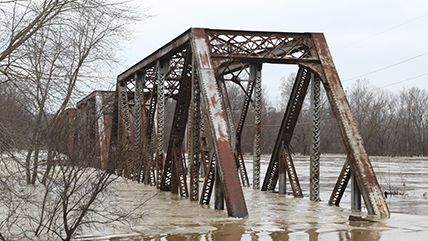Federal Infrastructure Spending Is a Bad Deal
Trump should choose privatization over nationalization.

In his first address as president-elect, Donald Trump repeated his campaign promise to invest in America's infrastructure. "We are going to fix our inner cities and rebuild our highways, bridges, tunnels, airports, schools, hospitals," he said. "We're going to rebuild our infrastructure, which will become, by the way, second to none. And we will put millions of our people to work as we rebuild it."
His plan is for the federal government to entice private investors with $137 billion in tax credits. The idea is that this will unleash up to $1 trillion worth of infrastructure investment over 10 years, spur economic growth, and create countless American jobs.
Politicians' love affair with infrastructure spending isn't new. Hillary Clinton, Bernie Sanders, Barack Obama, George W. Bush, and many before them have paid their respects to the idea. Economists have long recognized that roads, bridges, airports, and canals are the conduits through which goods are exchanged, and as such, infrastructure can play a productive role in economic growth.
But not all infrastructure spending is equal. Ample literature shows, in fact, that it's a particularly bad vehicle for stimulus and does not, in practice, boost short-term jobs or economic growth. To work that way, government spending would have to be used quickly to put the unemployed to work on shovel-ready projects. But as Obama discovered in 2009 when he tried to spend $47 billion from the American Recovery and Reinvestment Act on infrastructure, there aren't that many shovel-ready projects lying around. And since job seekers rarely have the skills needed to start building a bridge or highway right away, employers are forced to poach workers from their existing jobs.
Publicly funded infrastructure projects often aren't good investments in the long term, either. Most spending orchestrated by the federal government suffers from terrible incentives that lead to malinvestment—resources wasted in inefficient ways and on low-priority efforts. Projects get approved for political reasons and are either totally unnecessary or harmed by cost overruns and corruption. For example, we know that infrastructure investment produces the highest returns when it supports already-expanding cities and regions. Yet politicians' tendency is to spend in declining areas, where dollars can't help as many people, such as Detroit and Cleveland.
Government statistics show that our infrastructure isn't actually crumbling. While conditions vary from state to state, the most recent data on highway quality (from 2012) classify 80 percent of urban highways as either good or acceptable. For rural highways, the figure is almost 97 percent. Meanwhile, the quality of bridges has improved as well. In 2004, 5.7 percent of bridges were classed as structurally deficient, meaning that the bridge isn't unsafe but that it could suffer from a reduction in its load-carrying activities. By 2014 that number had declined to 4.2 percent.
Still, our infrastructure could use some work. Recently, in a debate at the Aspen Ideas Festival with former National Economic Council Director Lawrence Summers, the economist Robert Barro noted that he was "glad that Larry and I can agree that fixing potholes is the most productive activity in government." Unfortunately, the political process is biased against dull but valuable projects, such as basic road maintenance, and biased in favor of flashy or grandiose projects, such as high-speed rail, the Big Dig, and the Bridge to Nowhere. The process also systematically overestimates the benefits and underestimates the price of infrastructure projects.
On the bright side, Trump wants to address the "mountain of red tape" that slows down construction projects. His plan would link spending to reforms that "streamline permitting and approvals, improve the project delivery system, and cut wasteful spending on boondoggles."
He shouldn't stop there. A new report by Michael Sargent at the Heritage Foundation encourages the president-elect to reduce the federal role in highway construction and mass transit. I would go further: He should put an end to the whole idea that infrastructure should be centrally planned, taxpayer-funded, and the responsibility of the federal (as opposed to state or local) government. The current system obliterates the discipline that comes from knowing a project needs to pay for itself to survive.
User fees should become our preferred option for funding infrastructure. That change kills two birds with one stone: It lessens the need for massive federal expenditures, and it gives the private sector an incentive to spend money on crucial but not exactly sexy maintenance tasks. As Aquamarine Investment Partners founder and CEO Joel Moser recently explained in Forbes, "No one will invest in the replacement of defective bridges that have no tolls, regardless of the tax abatement, unless a revenue stream is attached to those assets." Innovations can provide "many creative ways to link revenue streams to currently non-tolled assets," he adds. EZPass and cellphone technology could be used to pay for all roads. Alternatively, leasing contracts—such as the one between Australian investment consortium IFM Investors and the Indiana government covering the Indiana Toll Roads—would work well too.
If Trump wants the United States to have "world-class" infrastructure, the surest way is through market-based reforms that increase competition while reducing subsidies and regulations. Embrace real privatization, not federally directed private investments.
This article originally appeared in print under the headline "Federal Infrastructure Spending Is a Bad Deal."


Show Comments (46)